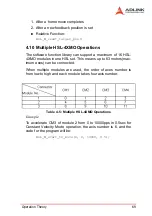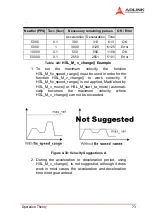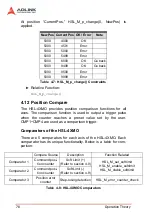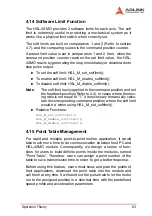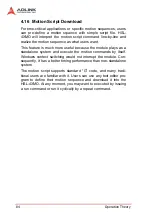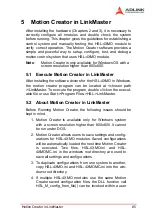
Operation Theory
71
The first 4 functions can be used for changing speed during a sin-
gle axis motion. Functions HSL_M_sd_stop() and
HSL_M_emg_stop() are used to decelerate the axis speed to “0.”
HSL_M_fix_speed_range() is necessary before any
HSL_M_v_change() function, and HSL_M_unfix_speed_range()
releases the speed range constrained by
HSL_M_fix_speed_range().
The function HSL_M_cmp_v_change() almost has the same func-
tion as HSL_M_v_change(), except HSL_M_cmp_v_change() acts
only when a general comparator comes into existence. Refer to
section 4.4.4 for more details about the general comparator.
The last 4 functions are relatively easy to understand and use. So,
the discussion below will be focused on HSL_M_v_change().
Theory behind HSL_M_v_change():
The HSL_M_v_change() function is used to change MaxVel on the
fly. In a normal motion operation, the axis starts at StrVel speed,
accelerates to MaxVel, and then maintains MaxVel until it enters
the deceleration region. If MaxVel is change during this time, it will
force the axis to accelerate or decelerate to a new MaxVel in the
time period defined by the user. Both Trapezoidal and S-curve pro-
files are applicable. The speed changes at a constant acceleration
for a Trapezoidal and constant jerk for a S-curve profile.
Summary of Contents for HSL-4XMO
Page 4: ......
Page 16: ...6 Introduction ...
Page 36: ...26 Signal Connections ...
Page 67: ...Operation Theory 57 Home Search Example Home mode 1 Figure 4 29 Home Search Example ...
Page 108: ...98 Motion Creator in LinkMaster ...













